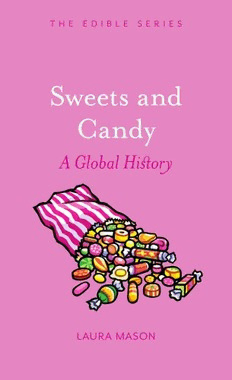
Sweets and candy: a global history PDF
Preview Sweets and candy: a global history
sweets and candy Edible Series Editor: Andrew F. Smith edible is a revolutionary series of books dedicated to food and drink that explores the rich history of cuisine. Each book reveals the global history and culture of one type of food or beverage. Already published Apple Erika Janik • Banana Lorna Piatti-Farnell Barbecue Jonathan Deutsch and Megan J. Elias • Beef Lorna Piatti-Farnell Beer Gavin D. Smith • Berries Heather Arndt Anderson Brandy Becky Sue Epstein • Bread William Rubel • Cake Nicola Humble Caviar Nichola Fletcher • Champagne Becky Sue Epstein Cheese Andrew Dalby • Chillies Heather Arndt Anderson Chocolate Sarah Moss and Alexander Badenoch Cocktails Joseph M. Carlin • Corn Michael Owen Jones Curry Colleen Taylor Sen • Dates Nawal Nasrallah Doughnut Heather Delancey Hunwick • Dumplings Barbara Gallani Edible Flowers Constance L. Kirker and Mary Newman Eggs Diane Toops • Fats Michelle Phillipov Figs David C. Sutton • Game Paula Young Lee Gin Lesley Jacobs Solmonson • Hamburger Andrew F. Smith Herbs Gary Allen • Herring Kathy Hunt • Honey Lucy M. Long Hot Dog Bruce Kraig • Ice Cream Laura B. Weiss • Lamb Brian Yarvin Lemon Toby Sonneman • Lobster Elisabeth Townsend Melon Sylvia Lovegren • Milk Hannah Velten • Moonshine Kevin R. Kosar Mushroom Cynthia D. Bertelsen • Nuts Ken Albala • Offal Nina Edwards Olive Fabrizia Lanza • Onions and Garlic Martha Jay Oranges Clarissa Hyman • Oyster Carolyn Tillie • Pancake Ken Albala Pasta and Noodles Kantha Shelke • Pickles Jan Davison • Pie Janet Clarkson Pineapple Kaori O’Connor • Pizza Carol Helstosky Pomegranate Damien Stone • Pork Katharine M. Rogers Potato Andrew F. Smith • Pudding Jeri Quinzio • Rice Renee Marton Rum Richard Foss • Salad Judith Weinraub • Salmon Nicolaas Mink Sandwich Bee Wilson • Sauces Maryann Tebben • Sausage Gary Allen Seaweed Kaori O’Connor • Shrimp Yvette Florio Lane Soup Janet Clarkson • Spices Fred Czarra • Sugar Andrew F. Smith Sweets and Candy Laura Mason • Tea Helen Saberi • Tequila Ian Williams Truffle Zachary Nowak • Vodka Patricia Herlihy • Water Ian Miller Whiskey Kevin R. Kosar • Wine Marc Millon Sweets and Candy A Global History Laura Mason reaktion books For Derek Published by Reaktion Books Ltd Unit 32, Waterside 44–48 Wharf Road London n1 7ux, uk www.reaktionbooks.co.uk First published 2018 Copyright © Laura Mason 2018 All rights reserved No part of this publication may be reproduced, stored in a retrieval system, or transmitted, in any form or by any means, electronic, mechanical, photocopying, recording or otherwise, without the prior permission of the publishers Printed and bound in China A catalogue record for this book is available from the British Library isbn 978 1 78023 927 9 Contents 1 Sweet, Candy or Confection? 7 2 The Magic of Sugar 23 3 Spice and Everything Nice 59 4 Some Oddities 91 5 Manufacturers and Consumers 106 6 Sweets and Festivity 123 Recipes 139 References 145 Select Bibliography 153 Websites and Associations 157 Acknowledgements 160 Photo Acknowledgements 161 Index 164 1 Sweet, Candy or Confection? The British know exactly what they mean by a sweet, and North Americans, likewise, are certain about a candy. In their respective cultures each word means a sweet-tasting, inter- estingly textured, small, sugar-based item. It is eaten with the fingers and does not usually form part of a meal. Dazzling in colour, variable in shape, mostly long-lasting and sometimes tasting very strange, they are much loved by children. These seemingly inconsequential items are freighted with centuries of changing cultural attitudes, social and economic history, emotional attachments and divergent views on the role of sugar in health. Chocolate is an essential part of notions about sweets and candy, but, although extremely popular, it does not form part of this book except in passing. It has its own considerable history and cultural significance, and requires very different skills and equipment to those used with sugar. ‘Candy’ is a word of ancient derivation that can be traced back over millennia to India. Historians of sugar generally agree that the skill of refining cane juice first developed here, over two thousand years ago, together with a vocabu lary of Sanskrit-derived words, including sakkar and khanda. Both these probably indicated grades of solid sugar with a crystalline 7 Anon., Lady Offering Sweetmeats, 1810–30, oil on calico. An image from Persia, where, together with Egypt and Turkey, wealthy courts were important in developing and transmitting sugarworking skills. Rock candy on sale in a supermarket in the usa, 2016. texture. The words were transmitted with the skills of growing and refining sugar westwards through Persia, reaching the Eastern Mediterranean by the tenth century. They eventually gave European languages phrases such as Spanish azucar cande and English sugar-candy, describing sugar in a crystalline mass, such as that in sugar loaves. European settlers took sugar to the New World, and ‘candy’ became the term for small sugary items in North American English. ‘Sweet’ appears simply to be descriptive of candy: it is sweet to the taste. Some cultures are more interested in the idea than others, notably India, the Middle East and the Anglophone world. But the notion of ‘a sweet’ is more com- plex, as one writer found when considering different cultures: What is a sweet? When I first embarked on my research, it seemed simple. A sweet was a little something you carried around in your pocket to eat outside prescribed mealtimes. But that is a modern, Western idea of a sweet. In fact, every nation has its own idea of what a sweet might be.1 9
